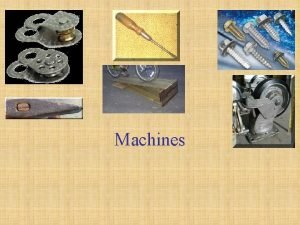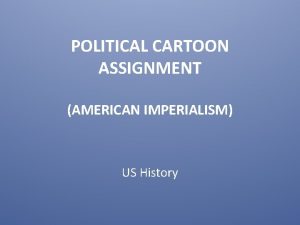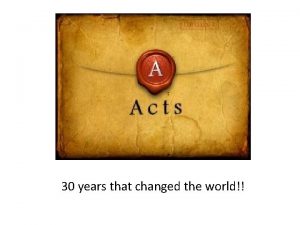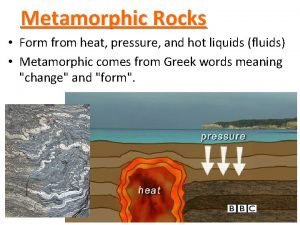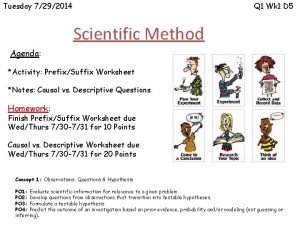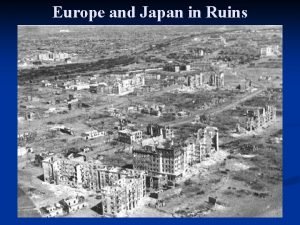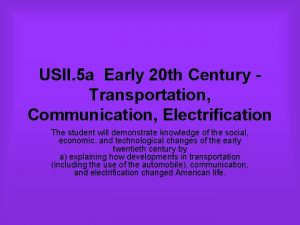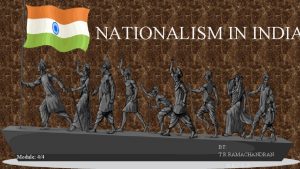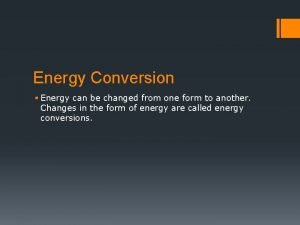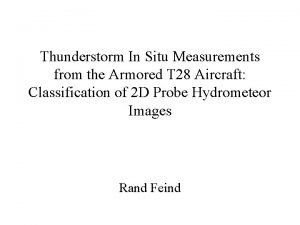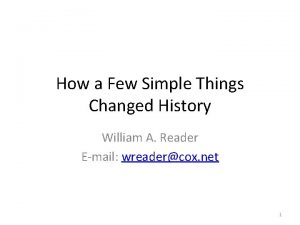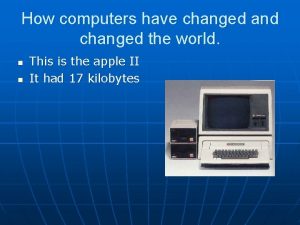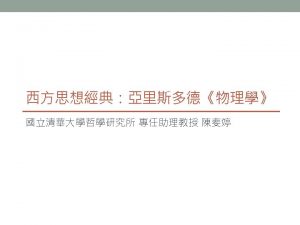How a Few Simple Things Changed History Class































![Ocean Steamers - 2 • In 1840, Samuel Cunard [Cunard Lines] developed transatlantic commercial Ocean Steamers - 2 • In 1840, Samuel Cunard [Cunard Lines] developed transatlantic commercial](https://slidetodoc.com/presentation_image_h2/f7d82a712e4da21e8612eeffd75b6b49/image-32.jpg)





































- Slides: 69

How a Few Simple Things Changed History Class 8 William A. Reader E-mail: wreader@cox. net 1

What We Will Cover Today • Clock – Consequences of the Clock – Clocks & Navigation – Watches • Steamboat/Steamship • Typewriter • Air Conditioner 2

Consequences of the Clock - 4 • Gave rise to the concept that time was something that could be saved and used • Gave rise to the notion of “being on time” • Once railroads and steamships came on the scene, gave rise to timetables 3

Consequences of the Clock - 5 • The clock created the idea of a numerically quantified and mechanical universe – Gave rise in the 18 th century to the Deist notion that the universe was analogous to a clock that God wound up at the beginning of time and allowed to unwind in accordance with Newtonian laws • Deism provided the first intellectual challenge to Christianity since the rise of Islam 4

Impact of Deism • Led to the alienation of Western intellectuals from traditional Christianity – In America, this led to the First Amendment and the separation of church and state – In France, it eventually, in combination with other factors, led to the French Revolution • Eventually led many intellectuals to agnosticism and atheism – Some Deists became Unitarians while others reverted back to traditional Christianity 5

Consequences of the Clock - 6 • Impacted upon Western theology and philosophy – Paley used the analogy of a watch implying the existence of a watchmaker to argue that the existence of the universe implied the existence of God 6

The Clock & Navigation • The clock facilitated ocean-going navigation – One problem that led to many shipwrecks was not knowing where your ship was – latitude could be precisely determined but not longitude – But longitude could be understood as a function of time – every 24 hours the earth rotates through 3600 • Each degree of longitude equals 4 minutes of time 7

The Clock & Navigation - 2 • In 1707, 4 Royal Navy ships capsized off the Scilly Isles because of a longitude miscalculation – In 1714, Queen Anne offered a £ 20, 000 reward to anyone who found a way to calculate longitude to within half a degree • What was needed was a clock that could keep precise time at sea • In 1759, clockmaker John Harrison created a chronometer that could do just that. 8

The Clock & Mass Production • The clock and the gun were the first precisionmachined items to be mass-produced – In 1806, Eli Terry began mass production of clocks – In 1838, the brass clock was invented • Starting in the late-18 th century, the Frenchspeaking Jura section of Switzerland became the world’s center of watch manufacture 9

Watches • The railroads created a major market for watches among railroad employees and passengers • World War I led to the wrist watch replacing the pocket watch since the former was much more useful in a battlefield situation – When the doughboys came home, they continued and popularized the practice of wearing wristwatches 10

Impact of the Wristwatch • It enabled individuals to order their life and work in a manner once reserved to the community – where the town clock was visible to all – Personalization of time was a major stimulus to individualism • It made time pieces both a fashion statement and a status symbol – A fine watch became a mark of status 11

Impact of the Steamboat & Steamship 12

Definition • Steamboat = a boat driven by steam power; specifically : a shallow-draft vessel used on inland waterways • Steamship = a : a ship propelled by steam b : an engine, machine, or vehicle operated or propelled by steam 13

Steamboats & Steamships • The term steamboat is usually used to refer to smaller steam-powered boats working on lakes and rivers, particularly riverboats; steamship generally refers to larger steam-powered ships, usually ocean-going. • Screw-driven steamships generally carry the ship prefix "SS" before their names, meaning 'Steam Ship’, paddle steamers usually carry the prefix "PS" and steamships powered by steam turbine may be prefixed "TS" (turbine ship) 14

Steamboat 15

Steamship 16

History - 1 • The concept of the steamboat was an outgrowth of the steam engine • The first working steamboat (with rotating paddles) by Marquis Claude de Jouffroy sailed in July 1776 • In the 1789 s, James Rumsey and John Fitch both built working steamboats • In 1802, Patrick Miller & William Symington built the Charlotte Dundas which towed barges along the Forth and Clyde canal to Glasgow 17

History - 2 • In 1803, Robert Fulton built a steamboat on the River Seine. • In 1807, he built the North River Steamboat (also known as the Clermont) which began regular passenger service between New York City and Albany • Fulton’s success was soon followed by the use of steamboats on major U. S. rivers and also on the great lakes – First steamboat on the Ohio and Mississippi sailed in 1811 18

History - 3 • Steamboat traffic including passenger and freight business grew exponentially in the decades before the Civil War. • First steam-powered vessel to cross the Atlantic was the hybrid steam- and sail-powered SS Savannah which sailed from Savannah GA to Liverpool in May-June 1819 • The first steamer to sail the Atlantic was the Dutch-owned Curacao which sailed from near Rotterdam to Surinam in 1827 19

History - 4 • The first regularly scheduled trans-Atlantic crossings by steamer began in 1838 with the SS Great Western • The first East Coast (New York City) to West Coast (San Francisco) steamship service began in October 1848 via Cape Horn • Steamers with screw propellers began replacing paddlewheel ships in the 1860 s-1870 s • The first trans-Atlantic steamer built of steel began sailing in 1879 20

History - 5 • Steamships dominated trans-Atlantic passenger travel until the 1960 s when jet airplane flights replaced steamships – The last scheduled liner voyage to cross the Atlantic was the Queen Elizabeth 2 in 1986 • In 1884, Sir Charles Parsons devised the marine steam turbine engine. – It gradually replaced the traditional reciprocating steam engine due to the turbine’s small size, low maintenance, light weight, and low vibration – The first steam turbine ship was the Turbinia, launched in 1894 21

Impact of the Steamboat • Revolutionized domestic transportation by making it easy for boats to travel upstream and do so at much less cost and much greater speed than before • Created new legal and political precedents that would have immense significance in later years – Supreme Court case of Gibbons vs. Ogden – Legislation that established the authority of the Federal Government to regulate an industry in the interest of public safety 22

Impact of the Steamboat - 2 • Subjected their passengers and cargoes in the early years to the dangers of boiler explosions, often with large-scale loss of life – This, in turn, led to the first Congressional regulatory legislation and the first regulatory Federal personnel – Also led to the precedent of Federal Government research grants 23

Steamboat Act of 1838 • Provisions – Had provisions for the prevention of collisions and the control of fires aboard ship – Required the inspection of hulls and the carrying of lifeboats – Required federal judges to appoint competent boiler inspectors who would semi-annually inspect every steamboat boiler, ascertain its soundness, certify it with a recommended working pressure, and issue a certificate of navigability – Made steamboat owners liable to both criminal penalties and to civil suits for damage to persons or property for a boiler explosion, with the fact of an explosion considered prima facie evidence of negligence • Had little effect in reducing boiler explosions 24

Steamboat Act of 1852 • Provisions – Set maximum allowable working pressures (110 lbs per sq. in. ) – Required every boiler to be tested yearly at 1 ½ times working pressure – Set boiler material construction standards – Required all steam engineers to be licensed – Authorized boiler inspectors to order repairs – Established boards of inspectors to investigate accidents and law infractions, giving them subpoena power • Did reduce steamboat accident fatalities by about 35% 25

Impact of the Steamboat - 3 • Turned Cincinnati OH into a major hog meatpacking center – The presence of a large amount of lard led William Proctor and James Gamble to form a partnership to turn some of that lard into soap • This initiated an early replacement of an item previously manufactured in the household by a mass consumer product 26

Impact of the Steamboat - 4 • Fostered a demand for Federally-financed internal improvements, especially the dredging of rivers and harbors (as well as the building of roads and canals) • This demand in turn provoked opposition from those in inland areas who would not benefit from such improvements and from those who feared the erosion of states rights • These policy differences help define, and became a bone of contention between, the Whigs who favored such internal improvements and the Democrats who opposed them 27

Impact of the Steamboat -5 • Fostered a mutually beneficial and symbiotic relationship with the Post Office – Steamboats aided in the transport and delivery of mail; the Post Office gave lucrative mail delivery contracts to the steamboat owners – Provided a model for the relationships the Post Office developed with the railroads 28

Impact of the Steamboat - 6 • Helped start and facilitate travelling for pleasure – Affluent Americans begin to use the steamboat for “nuptial journeys” – Wealthy Southern planters begin to come North during parts of the Summer months 29

Impact of the Steamboat - 7 • Along with breech-loading rifles and machine guns, the steamboat allowed Europeans to penetrate into the interior of China and Southeast Asia • Along with quinine, the steamboat allowed Europeans to penetrate into the interior of the continent of Africa – This allowed commercial and eventually political domination of the African hinterland. Formerly, Europeans avoided the African interior because of the likelihood of being infected with malaria 30

Ocean Steamers • While steam power was an obvious advantage for boats on rivers and lakes, it was much less of an advantage on ocean-going ships because the amount of fuel that had to carry limited the amount of space available for carrying cargo – Thus, early steam-powered ocean vessels were hybrids, using steam to maneuver independently of the wind and sail to conserve fuel 31
![Ocean Steamers 2 In 1840 Samuel Cunard Cunard Lines developed transatlantic commercial Ocean Steamers - 2 • In 1840, Samuel Cunard [Cunard Lines] developed transatlantic commercial](https://slidetodoc.com/presentation_image_h2/f7d82a712e4da21e8612eeffd75b6b49/image-32.jpg)
Ocean Steamers - 2 • In 1840, Samuel Cunard [Cunard Lines] developed transatlantic commercial steamships that used coal rather than wood (which took up more space) • Steamers made possible regularly-scheduled transoceanic trips with exact times of departure and scheduled times of arrival at a destination 32

Ocean Steamers - 3 • Steamers were much faster than sailing ships • In the 1840 s, It took a westward-bound sailing ship an average 34 days to cross the Atlantic; it took a steamship only 14 days to cover the same distance • In 1775, it took a sailing ship 36 days to sail from New York City to London; in 1850, it took a clipper ship 14 days; in 1901, it took a steamship 8 days 33

Ocean Steamers - 4 • In comparison with sailing ships, Steam powered ships: – – Could be constructed of iron/steel rather than wood Could be much larger than sailing ships Could carry more cargo Required fewer men to operate • As a result, shipping costs dropped, especially as the technologies of the screw propeller and marine steam turbine engine became common – Between 1879 -1902, the cost of shipping 8 bushels of wheat from Chicago to London fell from an average 11 shillings to less than 3 shillings 34

Refrigerated Ships • By the late-1870 s, refrigerated ships had been developed that could transport frozen meat and fish from the U. S. , Canada, Australia, and New Zealand to Europe – This vastly increased the amount of food that was traded. From the 1850 s to 1913, food exports rose from 4 million tons per year to 40 million tons 35

Consequences of Steamships - 1 • Faster, cheaper, and safer transoceanic travel – Facilitated the large-scale emigration of Europeans to the United States, Canada, Brazil, Argentina, Australia, New Zealand, and South Africa • Allowed an international market in wheat, rice, corn, meat, butter, wool, and other commodities to develop – This impacted negatively on the landed nobility and aristocracy of Russia, Germany, Poland, and Austria-Hungary 36

Consequences of Steamships - 2 • The economic decline of the landed aristocracies, both in absolute terms and relative to newly-emerging industrial elites, led many in these aristocracies to espouse Tory Socialism on the one hand extreme Nationalism, Imperialism, Militarism, and Anti. Semitism on the other 37

Consequences of Steamships - 3 • Ended the centuries-old practice of piracy – Steamships were too expensive for pirates to purchase and too fast for pirate-manned sailing ships to capture – Only with the development of fast ocean-going motorboats and containerized cargo ships with only a handful of crew members would piracy (in areas of East Africa and Strait of Malacca 38

Impact of the Typewriter 39

Definition • Typewriter = a mechanical or electromechanical device with lots of keys that, when pressed, cause ink to be printed on a medium, usually paper. • Typewriter = a machine for writing in characters similar to those produced by printer's type by means of keyboard-operated types striking a ribbon to transfer ink or carbon impressions onto the paper 40

Early Typewriter 41

42

Typewriter • The typewriter as we know it was Invented by Christopher Sholes – Christopher Sholes: • Developed a workable typewriter in 1867, • Drew in some co-inventors to improve the device • Found a manufacturer in small-arms maker Remington – 1874 – First Remington typewriter – 1876 - Exhibited at the 1876 Centennial Exposition in Philadelphia – 1878 - Remington Model 2 typewriter – the manual typewriter as we remember it 43

Notes About the Typewriter • Initially marketed to authors, lawyers, clergymen, and court reporters – Court reporters were the first major adopters of the typewriter • Businessmen saw its commercial potential to speed up correspondence – The typewriter found large-scale popularity in the business office, then spread to government, and finally to individual authors and students 44

Effects of the Typewriter - 1 • Created a demand for typists and stenographers • Created a separation and specialization of clerical jobs – Feminized the clerical work force • This opened up a new niche for women, but also confined them to a subservient status • Impacted upon female fashion • Led people to start composing documents on the typewriter 45

Effects of the Typewriter - 2 • Revolutionized the Office – Produced text that was more legible than handwriting – With carbon paper, produced multiple copies of the same document • Revolutionized office filing • Multiplied the quantity of office records • Created the typewritten form 46

Effects of the Typewriter - 3 • Revolutionized the Office (cont) – Changed the furniture of the office • The roll top desk with pigeonholes gave way to the modern “Efficiency Desk” (created in 1915 for the Equitable Life Assurance Company) which was a flat-top table containing 4 or 7 shallow drawers underneath – Divided correspondence into official (typed) and personal (handwritten) 47

Effects of the Typewriter - 4 • Created a demand for carbon paper – Allowed the typewriter to create an attractive original and several acceptable copies • Led to the development of vertical file cabinets to store (and facilitate the retrieval of) documents and case files created by the typewriter and carbon paper 48

Effects of the Typewriter - 5 • Led manufacturers of consumer machinery to establish distribution and repair networks – As an early piece of machinery often in need of repair, the typewriter created the need for a distribution network to provide instruction, repair, service, and technical assistance functions • Impacted on how individuals were recruited into, and trained for, the legal profession – Reading law in a law office was replaced by law school as a means of educating and recruiting lawyers 49

Impact of Air Conditioning 50

Definition • Air Conditioner = a home appliance, system, or mechanism designed to dehumidify and extract heat from an area. The cooling is done using a simple refrigeration cycle. In construction, a complete system of heating, ventilation and air conditioning is referred to as “HVAC”. Its purpose, in a building or an automobile, is to provide comfort during either hot or cold weather. 51

Air Conditioner 52

Willis Carrier • Air conditioning began in 1902 when Willis Carrier designed a system that provided temperature, humidity control, and removal of dust and lint for the Sackett-Williams printing plant in Brooklyn NY to stabilize the registry of multicolor prints • The term “air conditioning” was coined in 1906 by a textile engineer, Stuart Cramer, who patented a device for humidifying the air inside textile mills 53

Willis Carrier - 2 • Air conditioning, however, did not take off until after World War I. There were several reasons for this: – The thermodynamics of air and water vapor mixtures was not fully understood until 1911 – Early air conditioners were large, bulky, expensive to install, expensive to operate, not fully reliable, and used toxic refrigerants (usually ammonia or carbon dioxide) 54

Willis Carrier - 3 • In 1922, Carrier invented a centrifugal compressor that used a safe refrigerant – dichlorethylene [C 2 H 2 Cl 2] – This reduced the size of the air conditioning units and made them easier to install and use – It made possible commercial “comfort air conditioning” as distinct from industrial “process air conditioning” 55

Air Conditioning • In 1922, Carrier installed an air conditioning system at Grauman’s Metropolitan Theater in Los Angeles • In 1924, the Rivoli Theater on Broadway decided to install a centrifugal compressor air conditioning system – The air conditioned Rivoli opened Memorial Day weekend in 1925. Result: ticket sales went up $100, 000 over the previous summer 56

Air Conditioning - 2 • Effects of Air Conditioning Theaters – Saved Hollywood films from the summer doldrums – Created a demand for air conditioning in other environments • Persuaded members of Congress to air condition the Capitol – House of Representatives air conditioned in 1928 – Senate air conditioned in 1929 57

Air Conditioning - 3 • Spread of Air Conditioning – Government • In 1930, air conditioning was installed in the West Wing of the White House • In 1931, the Supreme Court building was air conditioned • In 1935, the National Archives building was opened with air conditioning to preserve the records stored within 58

Air Conditioning - 4 • Spread of Air Conditioning – 2 – Commercial Office Buildings • 1926 – An 8 -story office building in Fresno CA • 1928 – The 21 -story Milam Building in San Antonia TX 59

Air Conditioning - 5 • In summary, the 1920 s & 1930 s laid the groundwork for home air conditioning by – Exposing people to air conditioned theaters, department stores, hotels, and office buildings – Inventing the room air conditioner (1930) – Discovering chlorofluorocarbons – refrigerants that were stable, non-flammable, non-toxic, odorless, and inexpensive to produce 60

Air Conditioning - 6 • By 1940, air conditioning had made inroads into factories, movie theaters, department stores, office buildings, ocean liners, Pullman cars, hospitals, funeral parlors, and hotels • In the 1950 s & 1960 s, air conditioning finally began to make inroads into the home • By the 1990 s, most one-family homes had central air conditioning 61

% of New One-Family Homes with and without Air Conditioning 1960 1970 1980 1995 With Central Air Conditioning 22. 5% 34. 0% 63. 0% 76. 0% 80. 0% Without Central Air Conditioning 77. 5% 66. 0% 37. 0% 24. 0% 20. 0% 62

Consequences of Air Conditioning - 1 • Created a new summertime reality that led to the decline of such traditional summertime customs and lifestyles as: – Spending the summer outdoors • Camping, sleeping outdoors, sitting on the front porch or front steps, hanging out on the street corner • Spending the evening at the drive-in movie, the outdoor theater, or the concert under the stars • Spending the days at the community swimming pool • Driving a convertible with the top down – – Wearing white or light-colored summer suit or dress The afternoon nap Leaving the city in July/August for the beach or mountain cabin Frequenting the ice cream parlor, the soft drink fountain, the lemonade stand, & the Good Humor truck 63

Consequences of Air Conditioning - 2 • Led to the development of new summer customs and lifestyles such as: – Living life in air conditioned spaces – from the air conditioned house to the air conditioned car to the air conditioned office to the air conditioned mall back to the air conditioned home – Wearing of year-round suits and dresses in summer – Summer vacations at partially air conditioned theme parks • Disneyland, Sea World, Busch Gardens 64

Consequences of Air Conditioning - 3 • Created an introverted family-centered, workcentered, and school age-group-centered lifestyle – People socialize with relatives, fellow workers, & schoolmates rather than next-door neighbors (whom they now often don’t even know) – People watch television or go on-line or play computer games in their air conditioned living rooms 65

Consequences of Air Conditioning - 4 • Changed the architectural patterns of office buildings and houses – Completely-sealed office buildings with windows that do not open – Disappearance of the front porch, the window awning, the veranda, and the ceiling fan • Led to greatly increased usage of electricity in summer – Summer replaces winter as the peak season of electricity usage – Concomitant expansion of electrical generating facilities, leading to the increased emission of air pollutants and greenhouse gases 66

Consequences of Air Conditioning - 5 • Increased summertime work productivity – No seasonal layoff of workers in hot factories – No relatively-common early dismissal of office or factory workers when the temperature & relative humidity reaches a certain level – Less fatigued summer workforce – More comfortable working conditions 67

Consequences of Air Conditioning - 6 • Facilitated population shifts from the colder Northeast and Midwest to the warmer Sunbelt – Turned places like Houston TX, Dallas TX, Phoenix AZ and Las Vegas NV from sleepy towns into bustling metropolises • Created a new industry based on the production, installation, and repair of air conditioning systems 68

Consequences of Air Conditioning - 7 • Led to the large-scale production of chlorofluorocarbons which served to deplete the ozone layer • Helped foster the rise of a big Federal Government – Changed the way Congress operates – Made the Federal bureaucracy more efficient – Facilitated the creation of “iron triangles” 69
 She's lucky she has few problems
She's lucky she has few problems Few a few ero
Few a few ero Few, a few, little, a little exercise
Few, a few, little, a little exercise Complete the sentences using these words
Complete the sentences using these words A photograph that changed the world
A photograph that changed the world Favorite things poem
Favorite things poem Simple machines have got few or no moving parts
Simple machines have got few or no moving parts Venn diagram living and non living
Venn diagram living and non living What are the seven life processes of living things
What are the seven life processes of living things Future simple
Future simple Simple past simple present simple future
Simple past simple present simple future Present simple present continuous past simple future simple
Present simple present continuous past simple future simple презент перфект упражнения
презент перфект упражнения Simple present simple future
Simple present simple future Present simple present continuous past simple exercises
Present simple present continuous past simple exercises Facts about tenses
Facts about tenses Simple present exemplos
Simple present exemplos Present simple past simple future simple
Present simple past simple future simple Nothings changed poem
Nothings changed poem How have attitudes towards immigrants changed over time
How have attitudes towards immigrants changed over time Jacob name changed to israel
Jacob name changed to israel Process capability baseline
Process capability baseline American imperialism political cartoon
American imperialism political cartoon How computers have changed over time
How computers have changed over time Franz kafka
Franz kafka Aral sea changed over time
Aral sea changed over time Drag truss
Drag truss Organisms changed because they wanted to survive
Organisms changed because they wanted to survive Asian inventors that changed the world
Asian inventors that changed the world 30 years that changed the world
30 years that changed the world How changed
How changed Caitlin and martin ganda
Caitlin and martin ganda Regional metamorphism
Regional metamorphism Macbeth act two scene two
Macbeth act two scene two Living a changed life
Living a changed life How has technology changed sports
How has technology changed sports Dave grolsh
Dave grolsh Hypothesis statement
Hypothesis statement Lord i come to you
Lord i come to you Five equations that changed the world
Five equations that changed the world Europe and japan in ruins
Europe and japan in ruins Ways electrification changed american life
Ways electrification changed american life Has the exchange rate changed chapter 10
Has the exchange rate changed chapter 10 When the word oat is changed to the word boat the number of
When the word oat is changed to the word boat the number of Indian flag changed how many times
Indian flag changed how many times Has the exchange rate changed chapter 10
Has the exchange rate changed chapter 10 Energy can be changed from one form to another
Energy can be changed from one form to another History also history physical
History also history physical What about today's class
What about today's class Putting a package together
Putting a package together Difference between abstract class and concrete class
Difference between abstract class and concrete class How to calculate mode for grouped data
How to calculate mode for grouped data Class i vs class ii mhc
Class i vs class ii mhc Difference between abstract class and concrete class
Difference between abstract class and concrete class Class width
Class width Stimulus
Stimulus Discrimination training
Discrimination training Therapeutic class and pharmacologic class
Therapeutic class and pharmacologic class Class maths student student1 class student string name
Class maths student student1 class student string name How to find class boundaries
How to find class boundaries In greenfoot, you can cast an actor class to a world class?
In greenfoot, you can cast an actor class to a world class? Static and dynamic class loading in java
Static and dynamic class loading in java Esd class 0 vs class 1
Esd class 0 vs class 1 Aggregation vs composition
Aggregation vs composition Class 2 class 3
Class 2 class 3 Extends testcase
Extends testcase Package mypackage class first class body
Package mypackage class first class body Class third class
Class third class What is class attribute in java
What is class attribute in java Component class has composite class as collaborator
Component class has composite class as collaborator






